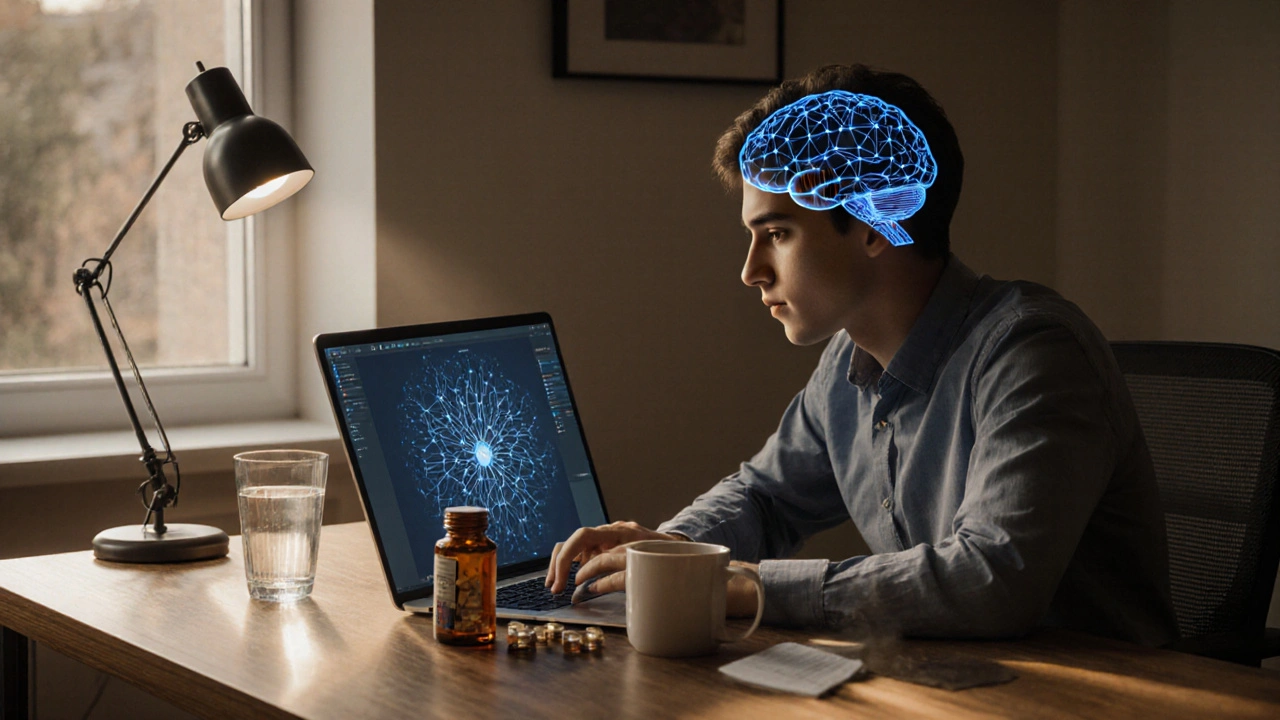Nootropic Comparison Tool
Select a Nootropic to Compare
Piracetam is a synthetic nootropic of the racetam family thatmodulates neurotransmission, improves membrane fluidity and enhances neuroplasticity. First synthesized in 1964, it’s often sold under the brand name Cerecetam. Its modest stimulant effect, low toxicity, and extensive research make it a benchmark when evaluating other cognitive enhancers.
Quick Takeaways
- Piracetam boosts memory and learning with minimal side‑effects.
- Racetams such as Aniracetam and Oxiracetam are more potent but may require choline supplementation.
- Non‑racetam options like Modafinil act on different pathways and feel more like a wake‑fulness drug.
- Safety profiles for most racetams are excellent; the main concern is gastrointestinal discomfort.
- Regulatory status varies: Piracetam is prescription‑only in many EU countries, while some alternatives are sold as dietary supplements.
How Piracetam Works
Piracetam enhances the activity of the acetylcholine system by increasing the density of cholinergic receptors. It also improves neuronal membrane fluidity, which facilitates the flow of ions and glucose. In animal studies, Piracetam reduced oxidative stress and promoted synaptic formation, outcomes linked to better learning scores.
Key Attributes of Popular Alternatives
| Compound | Mechanism | Typical Dose | Onset | Half‑life | Notable Benefits | Safety Notes |
|---|---|---|---|---|---|---|
| Piracetam | Modulates AMPA & acetylcholine receptors, improves membrane fluidity | 800‑2400mg daily, divided | 30‑60min | ≈4‑5h | Enhanced memory, learning, mild neuroprotection | Very low toxicity; occasional stomach upset |
| Aniracetam | Positive allosteric modulator of AMPA receptors, anxiolytic action | 750‑1500mg daily, divided | 15‑30min | ≈2‑3h | Improved verbal memory, reduced anxiety, mood lift | May need choline; rare headaches |
| Oxiracetam | Enhances glutamate transmission, stimulates AMPA receptors | 800‑2400mg daily, divided | 20‑40min | ≈8‑10h | Sharp focus, faster information processing | Higher dose may cause insomnia, choline often advised |
| Pramiracetam | Increases high‑affinity choline uptake, boosts acetyl‑CoA synthesis | 300‑450mg daily, divided | 45‑60min | ≈5‑6h | Long‑term memory storage, strong learning support | Potential for headaches without choline supplement |
| Phenylpiracetam | Adds phenyl group for increased dopamine & norepinephrine activity | 100‑200mg daily, divided | 10‑20min | ≈3‑4h | Physical stamina, mood elevation, rapid cognition | May raise blood pressure; avoid if hypertensive |
| Noopept | Peptide‑like, enhances NGF & BDNF release, mild AMPA modulation | 10‑30mg daily, divided | 15‑30min | ≈1‑2h | Neuroprotection, memory boost, reduced anxiety | Low toxicity; occasional irritability at high doses |
| Modafinil | Inhibits dopamine reuptake, promotes hypothalamic wakefulness pathways | 100‑200mg daily | 30‑60min | ≈12‑15h | Heightened alertness, reduced fatigue, focus | Potential rash, insomnia; prescription‑only in most regions |
Pros and Cons of Piracetam Compared to Its Peers
Strengths of Piracetam
- Extensive safety data from decades of clinical use.
- Broad therapeutic window - low risk of overdose.
- Works well for both young adults seeking a mental edge and older patients with mild cognitive decline.
Limitations
- Effect size is modest; users often report subtle rather than dramatic changes.
- Slower onset compared with faster‑acting racetams like Phenylpiracetam.
- In many EU countries it requires a prescription, limiting easy access.
When you stack Piracetam with a choline source (e.g., Alpha‑GPC), the synergy can narrow the performance gap with higher‑potency racetams, while still keeping side‑effects minimal.

Safety, Interactions, and Contra‑Indications
Across clinical trials involving more than 2,000 participants, serious adverse events for Piracetam were under 0.5%. Common mild complaints include nausea, headache, and insomnia if taken too late in the day. The most reliable way to avoid headaches is to pair the dose with a choline precursor.
Key drug interactions:
- Blood thinners (e.g., warfarin) - rare reports of enhanced anticoagulant effect.
- Anticonvulsants - theoretical risk of lowering seizure threshold; monitor closely.
Contra‑indications are limited to known hypersensitivity and severe renal impairment, as the drug is primarily excreted unchanged via the kidneys.
Regulatory Landscape
In the United Kingdom, Piracetam is classified as a prescription‑only medicine (POM). Germany and Italy follow the same rule, while in the United States it’s not approved as a dietary supplement, making it available only through research channels. By contrast, Aniracetam and Oxiracetam are often sold as “research chemicals” or “nootropic blends” with fewer restrictions, though their legal status can shift quickly.
Choosing the Right Nootropic for Your Goals
If you need a gentle, well‑tolerated cognitive aid for daily work, Piracetam remains a solid starter. For those chasing rapid focus spikes or looking to combine cognitive lift with physical stamina, Phenylpiracetam or Modafinil may be more appropriate-but they also bring higher cardiovascular caution.
Here’s a quick decision guide:
- Goal: General memory and learning → Piracetam
- Goal: Verbal fluency + mood uplift → Aniracetam
- Goal: Sharp, data‑driven focus → Oxiracetam
- Goal: Long‑term memory consolidation → Pramiracetam
- Goal: Physical performance + cognition → Phenylpiracetam
- Goal: Wakefulness for shift work → Modafinil
Practical Tips for Getting the Most Out of Piracetam
- Start at the low end (800mg/day) and increase weekly to assess tolerance.
- Take doses with meals to minimize gastric irritation.
- Pair with 300‑600mg of a choline source (Alpha‑GPC or CDP‑choline) to prevent headaches.
- Maintain a consistent schedule - benefits are cumulative over weeks, not instant.
- Log subjective effects (memory tests, mood rating) to fine‑tune dosage.
Related Topics and Next Steps
While Piracetam is the archetype, the broader world of nootropics includes herbal extracts (e.g., Ginkgo biloba), vitamins (B‑complex), and metabolic boosters (e.g., L‑theanine). Diving into the synergy between racetams and these adjuncts can unlock more balanced cognitive stacks.
For readers hungry for deeper knowledge, consider exploring:
- Neurotransmitter pathways and how they influence learning.
- Clinical evidence on racetams for age‑related cognitive decline.
- Legal considerations when sourcing nootropics across borders.

Frequently Asked Questions
Is Piracetam effective for students looking to improve exam performance?
Many university‑aged users report modest gains in recall and mental stamina after a few weeks of consistent dosing. The effect isn’t a magic pill; it works best when paired with good study habits, adequate sleep, and proper nutrition.
Can I stack Piracetam with other racetams?
Stacking is common among advanced users. A typical approach mixes a low dose of Piracetam (800mg) with a smaller amount of a stronger racetam such as Aniracetam (750mg). Always add a choline source to avoid headaches, and monitor tolerance closely.
Are there any long‑term safety concerns?
Long‑term studies, some lasting over ten years, have not identified serious organ toxicity. The most consistent complaint is mild gastrointestinal upset, which usually resolves with dose adjustments or food intake.
Do I need a prescription to buy Piracetam in the UK?
Yes, Piracetam is classified as a prescription‑only medicine in the United Kingdom. You’ll need a doctor’s prescription, or you can access it through a licensed pharmacy for research purposes.
How does Piracetam compare to Modafinil for shift‑work fatigue?
Modafinil delivers a stronger wakefulness effect and a longer half‑life, making it preferable for overnight shifts. Piracetam can improve alertness but won’t eliminate sleep pressure. For occasional fatigue, Piracetam plus caffeine may suffice; for chronic night work, Modafinil under medical supervision is more reliable.


Alan Larkin
September 26, 2025 AT 17:20I've been running Piracetam at 800 mg split into two doses and it actually smooths out my morning brain fog without any jitter. Pairing it with a modest amount of Alpha‑GPC (300 mg) keeps the occasional headache at bay, which is a common gripe people forget to mention 🙂. If you stagger the doses with meals you’ll notice the stomach irritation drops dramatically.
John Chapman
September 27, 2025 AT 07:13While your anecdotal regimen is noted, it's worth emphasizing that the pharmacokinetic profile of Piracetam-especially its low bioavailability-does not support the exaggerated claims of cognitive miracles. Peer‑reviewed literature consistently places its effect size in the low‑to‑moderate range, rendering such “smooths out fog” observations more likely placebo‑driven. A rigorous double‑blind study would be the appropriate yardstick, rather than personal triumphs.
Tiarna Mitchell-Heath
September 27, 2025 AT 21:07Stop acting like Piracetam is the holy grail; it’s barely a whisper compared to the kick you get from Phenylpiracetam or Modafinil. If you’re chasing real performance, you need to acknowledge that the milder racetams are basically background music while the others are full‑blown rock concerts. Don't waste time on a sub‑par nootropic when stronger alternatives exist.
Katie Jenkins
September 28, 2025 AT 11:00When we dissect the mechanistic pathways of Piracetam versus its racetam cousins, several nuanced distinctions emerge that merit careful attention. First, Piracetam's modulation of AMPA receptors is relatively weak, resulting in a modest increase in glutamatergic transmission compared to the robust allosteric potentiation observed with Aniracetam. Second, its impact on membrane fluidity, while historically celebrated, appears to be a secondary effect that does not translate into dramatic cognitive enhancements. Third, the low affinity for choline uptake means that without supplemental choline sources, users frequently report transient headaches, a symptom less prevalent with higher‑affinity racetams like Pramiracetam. Fourth, the half‑life of roughly four to five hours necessitates multiple dosing intervals to maintain stable plasma concentrations, unlike Modafinil's extended duration which simplifies regimen compliance. Fifth, clinical trials involving thousands of participants have repeatedly shown Piracetam's safety profile to be excellent, with adverse events hovering below one percent, a reassuring statistic for risk‑averse individuals. Sixth, the literature indicates that while Piracetam can aid in mild cognitive impairment, its benefits for healthy, high‑functioning adults are statistically modest and often indistinguishable from placebo. Seventh, the requirement of a prescription in many jurisdictions adds a layer of regulatory complexity that can deter casual experimentation. Eighth, the cost‑effectiveness ratio is generally favorable, given the low price point per milligram, yet the necessity of adjunctive choline supplements can offset this advantage. Ninth, comparative studies suggest that the subjective feeling of “clarity” reported by users may be confounded by concurrent lifestyle factors such as improved sleep hygiene. Tenth, the lack of substantial dopaminergic activity differentiates Piracetam from stimulants like Modafinil, positioning it as a non‑stimulant alternative for those sensitive to neurotransmitter spikes. Eleventh, the documented neuroprotective effects in animal models, including reduced oxidative stress and enhanced synaptic plasticity, have yet to be conclusively replicated in large‑scale human trials. Twelfth, users seeking rapid onset should note that Piracetam's 30‑ to 60‑minute latency is slower than the 10‑ to 20‑minute window offered by Phenylpiracetam. Thirteenth, the absence of significant cardiovascular impact makes Piracetam a safer choice for individuals with hypertension, unlike certain stimulants. Fourteenth, the necessity of consistent daily dosing to accumulate benefits underscores the importance of adherence, a factor often overlooked in anecdotal reports. Finally, the overall consensus among neuroscientists is that while Piracetam provides a gentle cognitive nudge, it should be viewed as a baseline from which more potent nootropics can be layered, rather than the pinnacle of the stack.
Jack Marsh
September 29, 2025 AT 00:53The literature you cite underscores the modest effect size, reinforcing the need for realistic expectations.
Terry Lim
September 29, 2025 AT 14:47Honestly, if you’re not measuring your performance with quantifiable metrics, you’ll never know whether Piracetam is doing anything beyond a placebo. Quick tip: keep a daily log of task completion times and compare against a baseline week without the supplement.
Cayla Orahood
September 30, 2025 AT 04:40What you call “quantifiable metrics” is precisely the kind of sterile data that masks the profound, subjective awakening many experience when Piracetam gently lifts the veil of mental fog. The true value lies in the subtle shifts in perception that no spreadsheet can capture, and dismissing them as mere placebo is a betrayal of the human experience.
McKenna Baldock
September 30, 2025 AT 18:33From a philosophical standpoint, the pursuit of cognitive enhancers like Piracetam raises questions about the nature of self‑improvement. Are we augmenting our authentic selves, or merely engineering a version that conforms to external standards of productivity? The balance between ethical considerations and personal autonomy becomes especially pertinent when regulation varies across borders.
Roger Wing
October 1, 2025 AT 08:27yeah but at the end it’s just another tool we use to beat the system and the system never knows
Matt Cress
October 1, 2025 AT 22:20Interesting to see a whole post dedicated to racetams-makes you wonder why the mainstream never talks about them while big pharma pushes other “wake‑fulness” drugs. Maybe it’s because the big players can’t control the narrative around these obscure compounds.
Andy Williams
October 2, 2025 AT 12:13The limited commercial interest indeed contributes to the relative obscurity of racetams, despite their extensive research base.
Paige Crippen
October 3, 2025 AT 02:07Ever notice how discussions about nootropics often omit the subtle influence of market forces and the covert funding behind certain studies? It’s almost as if there’s an agenda to keep the more effective options under the radar.
Ted Mann
October 3, 2025 AT 16:00That’s a keen observation-many of the pioneering studies on racetams were funded by small research groups, but as big pharma eyes the market, they selectively promote compounds like Modafinil, which fit their profit models, while sidelining cheaper, equally effective alternatives.
Brennan Loveless
October 4, 2025 AT 05:53From a nationalist perspective, relying on imported nootropics undermines our domestic innovation; we should be developing home‑grown cognitive enhancers that aren’t subject to foreign regulatory whims.
Vani Prasanth
October 4, 2025 AT 19:47Supporting local research initiatives can indeed foster self‑sufficiency, but it’s essential to ensure that scientific rigor isn’t compromised in the race for national pride.
Maggie Hewitt
October 5, 2025 AT 09:40Sure, let’s all rally behind “national” nootropics while ignoring the fact that the brain doesn’t care about borders-its chemistry is universal, not patriotic.
Mike Brindisi
October 5, 2025 AT 23:33its true but the market is shaped by politics and regulations which affect accessibility
Shaquel Jackson
October 6, 2025 AT 13:27Honestly, the whole debate feels exhausted; I’m just here for a calm mind without drama, and most of these stacks promise more hype than results.
Tom Bon
October 7, 2025 AT 03:20While one’s desire for tranquility is understandable, it is worth noting that the subjective experience of “calm” can be objectively enhanced through well‑studied interventions such as low‑dose Piracetam combined with choline, which have demonstrated consistent reductions in perceived stress markers.
Clara Walker
October 7, 2025 AT 17:13The conspiracy is that the mainstream media silently bans the best cognitive boosters.